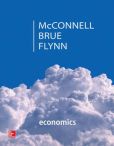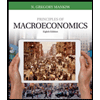
The four phases of a business cycle.
Explanation of Solution
The business cycle is the inherent cycle of changes in the market economy. The market economy moves through different phases of employment and growth and they work as a cycle. The changes are the alternative rises and falls in the level of economic activities. The main four phases of the business cycle are Peak, Recession, Trough and Recovery.
Peak: It is the highest point in the business cycle. The growth as well as the
Recession: It is the immediate phase in the business cycle which follows the peak phase. As a result of the higher levels of employment, output and the rise in the price level of the economy, there are market floods with goods and it leads to the decline in the output, employment and total output of the economy. As a result of the contraction of business in many firms, there is a sharp fall in the employment rate, total output as well as in the income of the economy. Thus, the economy moves from its maximum point to its minimum point during the recession.
Trough: This is the third phase of the business cycle. It is the lowest point of the economy where, the employment rate as well as the output is at their minimum points. The economy faces higher levels of
Expansion: It is the phase which follows the phase of Trough. It is the phase of economic expansion which leads to the increase in the employment as well as the output of the economy, which increases the gross domestic product of the economy. It is the movement of the economy from the trough towards the peak.
The period of a business cycle varies according to the cause of the business cycle. Some may complete in the short period of 2 years, whereas some may end up in only long period above 10 years or so on. The longest known business cycle period is 15 years.
The consumer durables are the goods that can be stored for a long period without damages. They include the furniture and other household items such as appliances. Whereas the non durables are the goods that cannot be stored for a long period of time. They will be perishable and they have to be consumed once they are produced. They include the food products.
Since the consumer durables last long, the consumers can wait for the recession to complete and this helps them to consume in the future period. The higher cost of consumer durables leads to the higher spending of money and it is not advised in the period of recession. As a result of this, the producers face a large decline in the output of the consumer durables during the period of recession. The food is an important element for the livelihood and thus, the people cannot postpone the purchase of such nondurable products and they have to be purchased and consumed even during the period of recession. Thus, the output of the consumer nondurables does not fall highly even during the recession period. So, it shows that the consumer durables face a large decline in the output, whereas the nondurables face only a slight decline in the output.
Concept introduction:
Business cycle: The business cycles are the alternating rises and declines in the level of economic activity over many years. Thus, the business cycles are the rises and falls in the gross domestic product of the country of its
Want to see more full solutions like this?
Chapter 27 Solutions
Economics: Principles, Problems, & Policies (McGraw-Hill Series in Economics) - Standalone book
- Fems A and B are duopolist producers of widgets. The cost function for producing widgets C(Q)-Q² The market demand function for widgets i Q-192P Qmeasures thousands of widgets per year, Competition in the widget market is described by the Coumot model Instructions: Round your answers to 2 decimal places a What are the firms' Nanh equbrium output? b. What is the resulting price? c. What do they each emp How does the price compare to marginal cost? Price is ck to marginal cost How do the price and the two fems' joint profit compare to the monopoly price and prof Compared to the monopoly price, the Cournot price is to sed. Compared to the monopoly profit, the joint profit of the two fems to selectarrow_forwardSuppose the marginal social cost of television sets is $100. This is constant and equal to the average cost of television sets. The annual demand for television sets is given by the following equation: Q = 200,000-500P, where Qis the quantity sold per year and P is the price of television sets. a) If television sets are sold in a perfectly competitive market, calculate the annual number sold. Under what circumstances will the market equilibrium be efficient? b) Show the losses in well-being each year that would result from a law limiting sales of television sets to 100,000 per year. Show the effect on the price, marginal social benefit, and marginal social cost of television sets. Show the net loss in well-being that will result from a complete ban on the sales of television sets. (show with graphs.)arrow_forwardrefer to exhibit 8.12 and identify each curve in the grapharrow_forward
- Q1. (Chap 1: Game Theory.) In the simultaneous games below player 1 is choosing between Top and Bottom, while player 2 is choosing between Left and Right. In each cell the first number is the payoff to player 1 and the second is the payoff to player 2. Part A: Player 1 Top Bottom Player 2 Left 25, 22 Right 27,23 26,21 28, 22 (A1) Does player 1 have a dominant strategy? (Yes/No) If your answer is yes, which one is it? (Top/Bottom) (A2) Does player 2 have a dominant strategy? (Yes/No.) If your answer is yes, which one is it? (Left/Right.) (A3) Can you solve this game by using the dominant strategy method? (Yes/No) If your answer is yes, what is the solution?arrow_forwardnot use ai pleasearrow_forwardsubject to X1 X2 Maximize dollars of interest earned = 0.07X1+0.11X2+0.19X3+0.15X4 ≤ 1,000,000 <2,500,000 X3 ≤ 1,500,000 X4 ≤ 1,800,000 X3 + XA ≥ 0.55 (X1+X2+X3+X4) X1 ≥ 0.15 (X1+X2+X3+X4) X1 + X2 X3 + XA < 5,000,000 X1, X2, X3, X4 ≥ 0arrow_forward
- Unit VI Assignment Instructions: This assignment has two parts. Answer the questions using the charts. Part 1: Firm 1 High Price Low Price High Price 8,8 0,10 Firm 2 Low Price 10,0 3,3 Question: For the above game, identify the Nash Equilibrium. Does Firm 1 have a dominant strategy? If so, what is it? Does Firm 2 have a dominant strategy? If so, what is it? Your response:arrow_forwardnot use ai please don't kdjdkdkfjnxncjcarrow_forwardAsk one question at a time. Keep questions specific and include all details. Need more help? Subject matter experts with PhDs and Masters are standing by 24/7 to answer your question.**arrow_forward
 Exploring EconomicsEconomicsISBN:9781544336329Author:Robert L. SextonPublisher:SAGE Publications, Inc
Exploring EconomicsEconomicsISBN:9781544336329Author:Robert L. SextonPublisher:SAGE Publications, Inc Principles of Economics 2eEconomicsISBN:9781947172364Author:Steven A. Greenlaw; David ShapiroPublisher:OpenStax
Principles of Economics 2eEconomicsISBN:9781947172364Author:Steven A. Greenlaw; David ShapiroPublisher:OpenStax Essentials of Economics (MindTap Course List)EconomicsISBN:9781337091992Author:N. Gregory MankiwPublisher:Cengage Learning
Essentials of Economics (MindTap Course List)EconomicsISBN:9781337091992Author:N. Gregory MankiwPublisher:Cengage Learning Principles of Economics (MindTap Course List)EconomicsISBN:9781305585126Author:N. Gregory MankiwPublisher:Cengage Learning
Principles of Economics (MindTap Course List)EconomicsISBN:9781305585126Author:N. Gregory MankiwPublisher:Cengage Learning Brief Principles of Macroeconomics (MindTap Cours...EconomicsISBN:9781337091985Author:N. Gregory MankiwPublisher:Cengage Learning
Brief Principles of Macroeconomics (MindTap Cours...EconomicsISBN:9781337091985Author:N. Gregory MankiwPublisher:Cengage Learning Principles of Macroeconomics (MindTap Course List)EconomicsISBN:9781305971509Author:N. Gregory MankiwPublisher:Cengage Learning
Principles of Macroeconomics (MindTap Course List)EconomicsISBN:9781305971509Author:N. Gregory MankiwPublisher:Cengage Learning





